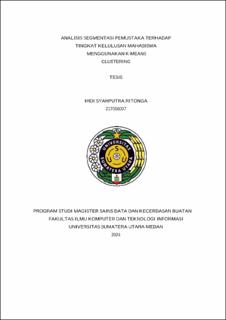Analisis Segmentasi Pemustaka terhadap Tingkat Kelulusan Mahasiswa Menggunakan K-Means Clustering
User Segmentation Analysis of Student Graduation Rates Using K-Means Clustering

Date
2024Author
Ritonga, Ihdi Syahputra
Advisor(s)
Candra, Ade
Budiman, Mohammad Andri
Metadata
Show full item recordAbstract
This research aims to analyze the use of library services and determine the correlation between user activity and student graduation through user segmentation using the K-Means algorithm. This research has several stages, namely: data collection, data preprocessing which includes data merging and cleaning steps, and data modeling. The dataset used is a collection of several library automation system and data graduation obtained from the UIN Padangsidimpuan Academic Information System (SIAKAD) website. Using one of the machine learning methods, namely the K-Means algorithm as a segmentation method to determine the correlation with student graduation rates. By using this algorithm on user data, it is hoped that libraries can identify patterns underlying preferences and can increase user visits. Based on the results of combining the two datasets, a circulation and graduation dataset was produced, students were grouped based on length of study, Grade Point Average (GPA) and loan level, thus identifying three groups with different characteristics. Clustering results can show the preferences and needs of libraries that can change their promotional strategies, change their book collections, and develop additional services that are more focused on meeting needs and increasing reader participation, such as providing special discussion services related to student research to increase the value and quality of theses or research as well as optimizing digital-based library services.
Collections
- Master Theses [626]
